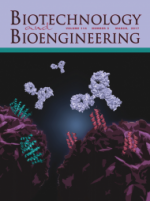In situ magnetic separation of antibody fragments from Escherichia coli in complex media
- Citation:
- Cerff, M, Scholz A, Franzreb M, Batalha IL, Roque ACA, Posten C. 2013. In situ magnetic separation of antibody fragments from Escherichia coli in complex media. BMC biotechnology. 13(1):44.
Abstract:
Background
In situ magnetic separation (ISMS) has emerged as a powerful tool to overcome process constraints such as product degradation or inhibition of target production. In the present work, an integrated ISMS process was established for the production of his-tagged single chain fragment variable (scFv) D1.3 antibodies (?D1.3?) produced by E. coli in complex media. This study investigates the impact of ISMS on the overall product yield as well as its biocompatibility with the bioprocess when metal-chelate and triazine-functionalized magnetic beads were used.
Results
Both particle systems are well suited for separation of D1.3 during cultivation. While the triazine beads did not negatively impact the bioprocess, the application of metal-chelate particles caused leakage of divalent copper ions in the medium. After the ISMS step, elevated copper concentrations above 120?mg/L in the medium negatively influenced D1.3 production. Due to the stable nature of the model protein scFv D1.3 in the biosuspension, the application of ISMS could not increase the overall D1.3 yield as was shown by simulation and experiments.
Conclusions
We could demonstrate that triazine-functionalized beads are a suitable low-cost alternative to selectively adsorb D1.3 fragments, and measured maximum loads of 0.08?g D1.3 per g of beads. Although copper-loaded metal-chelate beads did adsorb his-tagged D1.3 well during cultivation, this particle system must be optimized by minimizing metal leakage from the beads in order to avoid negative inhibitory effects on growth of the microorganisms and target production. Hereby, other types of metal chelate complexes should be tested to demonstrate biocompatibility. Such optimized particle systems can be regarded as ISMS platform technology, especially for the production of antibodies and their fragments with low stability in the medium. The proposed model can be applied to design future ISMS experiments in order to maximize the overall product yield while the amount of particles being used is minimized as well as the number of required ISMS steps.







